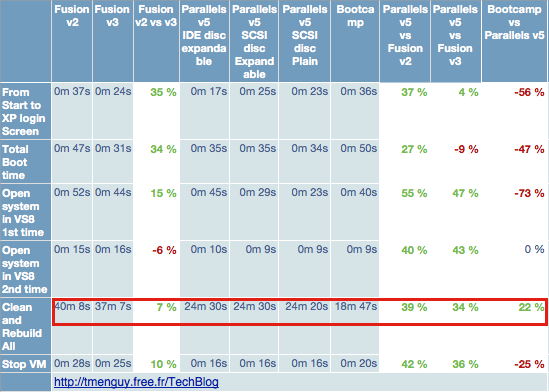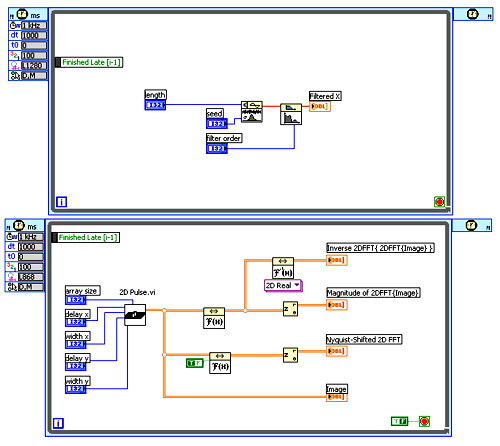[UPDATED] Parallels 5 vs VMWare fusion 3 vs Bootcamp for the visual studio developper, compilation benchs
Thomas Menguy | November 23, 2009[UPDATED : Added a BootCamp test to compare it to VM solutions, changed the Parallels boot time by the numbers obtained with a fresh VM with al my setup in it.]
It’s done, I’ve switched to MacOS … but I still work ![]() and still lead the Elips Studio dev team, and (for now) the product is still Windows Only.
and still lead the Elips Studio dev team, and (for now) the product is still Windows Only.
Yes, from time to time I need a window box to get some C/C++ work done. Bootcamp (ie booting winXP on a Mac) is not the best option for me as I’ve made the switch to have my mail, docs and all under MacOS.
So I’ve looked at a virtualization solution. I begun with VMWare Fusion 2 under Lepoard 1O.5.8 it really was OK , I’ve never looked at Parallels.
Here are some benchs I’ve made to configure my first VM:
For the exact same Build environment on my new top of the line MacBook Pro, 4GB RAM, 7200 rpm 500GB HDD, 3.06GHz Core 2 Duo CPU:
- My initial dell laptop (D630 2GB memory, 2GHz CPU): 5:40
- vm 2GB split no prealoc 8:20
- vm prealoc 40g :7:40
- vm prealoc 2GB split : 7:40
=> My old PC was 25% faster than my VM … well not that good but still usable on a daily basis.
Then I’ve switched to Snow Leopard, and I’m not sure but I really felt that my fusion VM began to slow down, I wasn’t able to conduct the same test to measure this degradation, so I’ve waited for VMWare Fusion 3 and Parallels 5 to fix it.
And here we are, they are both available:
The Bench setup:
- I’ve converted my initial Fusion 2 VM to Fusion V3 and Parallels v5.
- I’m building a Makefile Based Visual Studio Project of hundreds if not
thousands of C and C++ files (the whole ELIPS Studio runtime) - VMs configuration : 1.8 GB RAM, max performance settings, in fullsceen mode (no unity or coherence gadgets enabled), no shared stuffs
- Reboot of the MacBook between each tests
- UPDATED: added the same bench under Bootcamp

I was shocked by the awfully long boot time of my converted VM under parallels v5, so I’ve setup another VM with only XP in it, and … it boots pretty fast, so perhaps an issue with the conversion of my VM from VMWare to Parallels. The long phase is after the login, when XP is loading my “user preferences”, I’ll look at it more closely pretty soon. UPDATED: I now use a fresh VM, as seen in the number, no issues
Beside this:
- Fusion v3 seemed to be a nice improvement with its 64bits engine but with only 7% improvement for the build compared to v2, well this is disappointing
- Parallels v5 is just in another league, 39% faster than fusion v2 and 34% (a third!) than v3 for build…I’m faster than on my former laptop!
- … and Parallels just “feel” faster: UI is slightly more responsive as launching apps.
- UPDATED: Bootcamp: build time under bootcamp are 50% better than Fusion (so I Build twice as fast
 ), for Parallels we still have a 22% improvement, around 6mn, with 6 or 7 of those full build a day it is a 40mn improvement of my productivity…ok not so big, as I’m not able to do a lot of stuff under Windows (all my documents, settings, etc are under MacOS).
), for Parallels we still have a 22% improvement, around 6mn, with 6 or 7 of those full build a day it is a 40mn improvement of my productivity…ok not so big, as I’m not able to do a lot of stuff under Windows (all my documents, settings, etc are under MacOS).
Conclusion:
Well beside the boot time issue in Parallels (that I’m fixing using a “from scratch” VM), due to the speed increase in Visual I really can’t go back to VMWare for now.
I’ve just bought Parallels 5, and oh, they are offering a 30$ rebate if you have a VMware Fusion License (!! yes really, this is competition…), check it here, bottom right of the page.
UPDATED: After few days of heavy use, no stability issues with Parallels, The Mac is not slowed down when not compiling (as with Fusion), so really, for me Parallels is a superior product. I’m also experiencing Bootcamp : for sure it is really faster, but not so much compared to Parallels and I loose a lot in usability. The next test I’ll conduct is … building under a Bootcamp loaded as a VM in Parallels, perhaps the best of both world?
Other reviews and articles:
- Einar Ingebrigtsen has some nice tips to tweak your parallels VM … but my benchs are simply showing that plain disc and SCSI are not really faster.
- lostWhisper has a good head to head fusion v3 vs Parallels 5 comparison also: He prefers VMWare for dev… I don’t due to the size of our projects, I’m just more productive.
- The Mac Village Blog has a great screencast,
really helpfull to understand the two products, at the end of the
screencast you have a startup bench, where parallels really faster than
Fusion for startup (again I think my numbers for startup are biased) - ATLChris is also giving its view on the two products…and recommends Parallels 5 also
Parallels 5 really seems to be a winner for them also ![]()



















